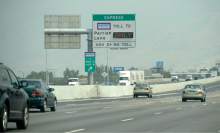This is an archived article that was published on sltrib.com in 2015, and information in the article may be outdated. It is provided only for personal research purposes and may not be reprinted.
One of about every five drivers in carpool lanes on Utah's Interstate 15 is breaking the law, the Utah Department of Transportation told legislators Wednesday.
To be exact, 18 percent of drivers there are violators who don't have the required two people in the car, pay tolls or otherwise qualify to be there legally.
UDOT reports that 56 percent of vehicles in the express lanes have two or more occupants, 17 percent are paying tolls, 7 percent have a "C decal" for clean-fuel vehicles and 2 percent are allowed buses or motorcycles.
Seeing so many violators is "something that drives me crazy," said state Rep. Dean Sanpei, R-Provo, who commutes daily between Provo and Salt Lake City and often watches those scofflaws zip by him in the express lane.
"I see them all the time. I wonder how effective is our enforcement?" he asked during a Transportation Interim Committee meeting. "Would changing our fines have an effect?"
UDOT Deputy Director Shane Marshall said the violation rate has remained constant for years — despite the threat of fines that average $162.
But Marshall conceded that the state doesn't do much to enforce the law.
"Enforcement is a tricky issue. That's a very tricky place to have people pull over," he said, noting that the express lane does not have much of a shoulder — so Utah Highway Patrol officers often must get drivers to cross several lanes to stop in the more-spacious, far-right shoulder.
The UDOT report said the Highway Patrol issued 1,616 tickets for violating the carpool lanes during the past 12 months and gave another 2,000 warnings. Marshall said that was down a bit because construction in Davis County and at Point of the Mountain suspended rules for express lanes there temporarily, or made enforcement difficult.
He said the Highway Patrol does an annual enforcement blitz for a few weeks to bring attention to express-lane rules, but has not yet performed one this year.
"There's some education we have to do," Marshall added. For example, he said, many owners of hybrid or clean-fuel vehicles believe they automatically qualify to drive in the express lane. But they must obtain a C decal. The state issues only 6,650 of them — and it sometimes reaches that limit.
Sanpei suggested that, beyond education, the state should consider making the fines extra high. That way even if "they don't catch them [violators] very often, when they do it, is severe enough that it creates a disincentive."
The report says that a high-occupancy vehicle (HOV) lane carries more people than a general-purpose lane, and is safer.
Because of car pooling, the lanes carry an average 2,420 people per hour compared with 1,848 in general purpose lanes, Marshall said.
Express lanes carried about 10 percent of the freeway traffic where they existed last year, but only had 7.4 percent of the crashes. Average speeds are 1-6 mph faster in most express lanes, although studies show some stretches in Utah County are actually slower than regular lanes.
When construction on express lanes on I-15 in Davis County is completed later this month, Marshall said, Utah will have 72 miles of express lanes from Spanish Fork to Layton.
He added that operation of the express lanes and their toll-transponder system cost $710,000 last year, but generated revenue of $950,000 — and the "profits" are being saved for needed upgrades.
The report Wednesday may be the last one ever issued on the topic. The committee endorsed a bill that no longer would require it and some other annual transportation reports — if approved later by the full Legislature.









